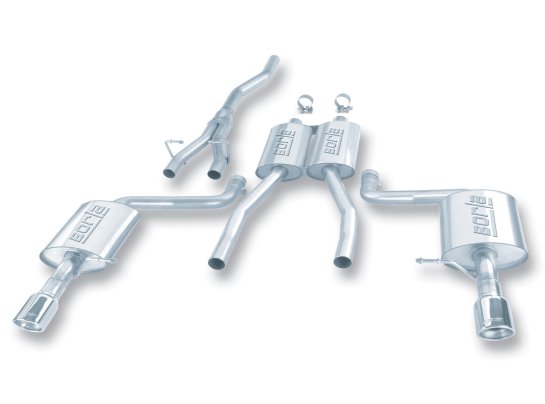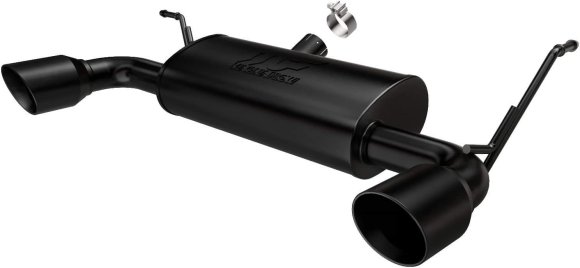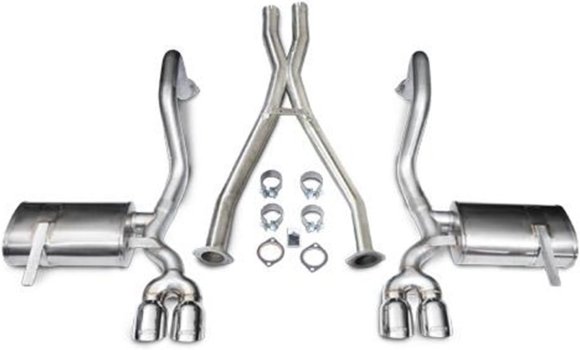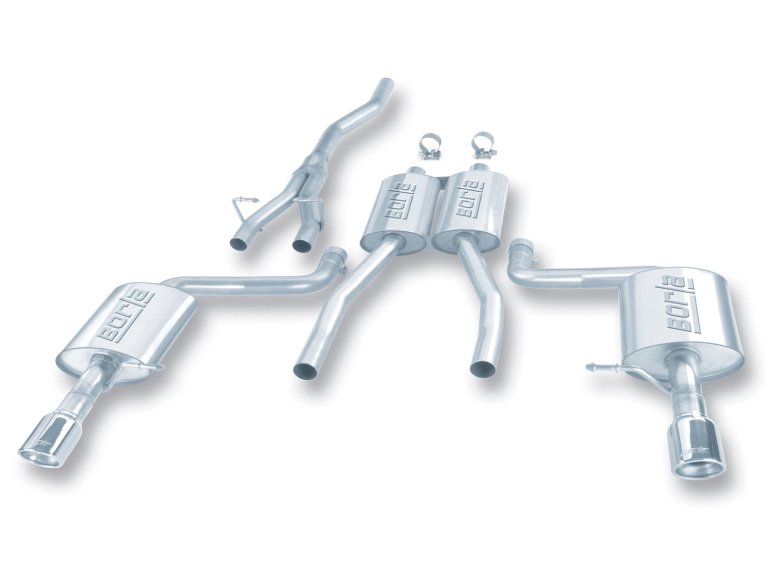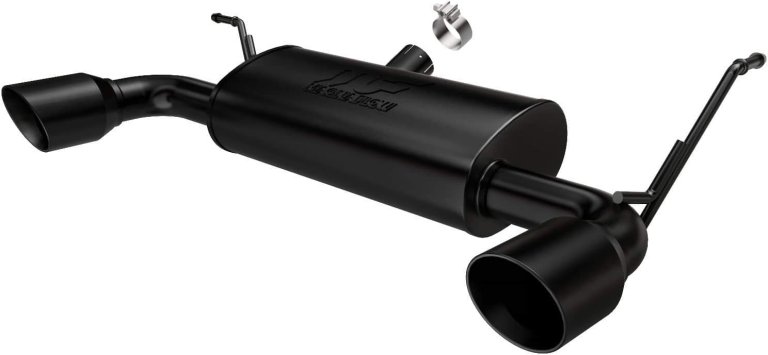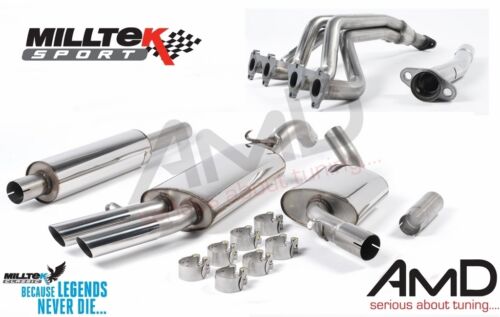We may earn revenue from the products available on this page and participate in affiliate programs. Learn more ›
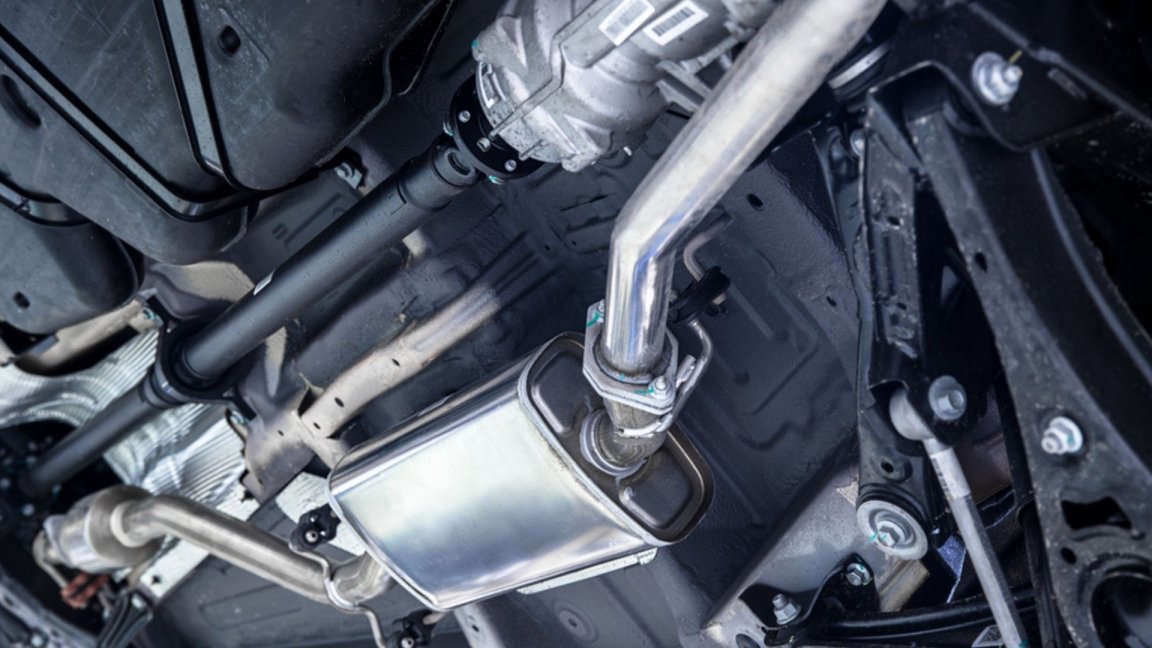
Well-engineered, bolt-on replacement exhaust systems are a relatively modern advancement. Up until the early 1980s, enthusiasts were forced to replace a rusted-out mess of mild steel piping with more OE heartache or have a system custom built from generic off-the-shelf mufflers and resonators with the results totally dependent on the fabricator’s current state of focus, karma, and sobriety.
While the automotive industry was switching over to longer-living stainless steel for exhaust components, the aftermarket was figuring out how to make reliable performance gains in a package that enthusiasts could bolt on with no fabrication or welding necessary. But with tightening fuel economy standards and car companies’ increased computing power, getting big gains from an aftermarket exhaust didn’t last long.Today, aftermarket exhaust systems are still a way to get better sound and looks while usually being more affordable than a replacement exhaust from the dealer. Reputable exhaust companies spend hours testing their systems for both sound and performance, so a kit designed specifically for your make and model is almost always superior to something put together with universal components. So let’s take a look at the best exhaust systems.
Summary List
- Best Overall: Borla Cat-Back Exhaust System
- Best Value: MagnaFlow Street Series Axle-Back Exhaust
- Honorable Mention: Corsa Performance Cat-Back Exhaust
- Best Project Car Exhaust: Milltek Classic Exhaust System
- Best Price-No-Object Exhaust: Akrapovic Titanium Exhaust System
Our Methodology
This guide was assembled using years of experience with aftermarket exhaust systems. Of all the cars I’ve owned or built as projects, my current daily driver is the only one to keep its factory exhaust system – it’s a VW Tiguan with a 2.0-liter turbo B-cycle engine and it will not benefit in performance or sound from any exhaust modification currently possible with earthling technology.
I have used exhaust systems from some of the biggest names in the business all the way down to custom-built track exhausts. All the dyno-testing, scraping over speed bumps, swapping components, and loss of hearing will culminate in the next few thousand words, all for you, Dear Reader.
When choosing the exhaust systems you see here, I considered everything from sound, to durability, to value and even looks. On modern cars, gaining any real performance is tough to do with an emissions legal system; car companies are far too good at optimizing everything that affects mpgs or 0-to-60 times. So, while some of these might net you a new pony or two, be skeptical of any company making big gain claims.
As my experience is mostly with performance cars, online ratings from actual users were also reviewed. Sound clips across the internet were also reviewed and quickly disregarded as I realized that neither the videographer’s smartphone nor my laptop possess the audio chops necessary to replicate the bellow of the big pipes.
Car Exhaust Systems: Reviews & Recommendations
Best Overall
Borla Cat-Back Exhaust System
See ItBest Value
MagnaFlow Street Series Axle-Back Exhaust
See ItHonorable Mention
Corsa Performance Cat-Back Exhaust
See ItBest Project Car Exhaust
Milltek Classic Exhaust System
See ItBest Price-No-Object Exhaust
Akrapovic Titanium Exhaust System
See ItOur Verdict on the Best Exhaust Systems
A quick internet search shows the average consumer has exactly, far too many choices when it comes to replacing their factory exhaust. As the overall best pick, I chose the Borla Cat-Back Exhaust System based on reputation, price, material, and build quality, as well as hands-on experience with every brand here and probably a dozen others. It’ll fit like factory, sound better and last the life of your car.
Consider Secondhand
When we start shopping for tools and products, we never overlook the secondhand market. In fact, it’s usually the first place I look. Whether you’re scrolling through Amazon’s Renewed section, eBay for car parts or tools, or flipping through the pages of Facebook Marketplace and Craigslist, you have hundreds of thousands of used tools, parts, and gear ready to be shipped to your doorstep. Refurbished to like-new status, they’ll be willing to give you many more years of faithful service all while saving you money.
If those options don’t have what you need, your local salvage yard is great for car parts, while swap meets are a great resource you should tap. Just Google either and head on down.
Secondhand Tips
To make your secondhand search easier, here are two tips to finding the best deals and making sure your new-to-you stuff wasn’t destroyed by the previous owner.
● Verify the exhaust’s legitimacy with serial or at minimum part numbers.
● Don’t buy anything with signs of modifications or parts replaced.
What to Consider When Buying Exhaust Systems
Spending the extra money on a high-quality replacement exhaust for your car is something you will appreciate daily. If you drive your car in anything but completely dry conditions, you want something made from stainless steel, and make sure it is good stainless; there’s plenty of crap out there that will still corrode. If you are concerned with noise and the manufacturer has multiple product lines, look for words like Touring, Street, Comfort and stay away from anything with Track, Attack, Blitz, and especially anything purposely misspelled.
Types of Exhaust Systems
Cat-Back
If you need a replacement exhaust because the factory system has rusted, cracked, or is otherwise pushing up daisies, you will want to replace the entire thing with a cat-back. As the name implies, this is a system that starts at the car’s catalytic converter and replaces everything from there back to the tailpipe(s). Since the original catalytic converter is untouched, these are emissions-legal in 50 states and won’t void your car’s warranty except in unusual cases.
Axle-Back
For enthusiasts looking to change the sound of their car and add different exhaust tips, this is a more budget-friendly option. As the name implies, these kits replace just the rear section of your exhaust, although this may be just before or even well behind the rear axle. The center section of your factory exhaust usually contains a resonator designed to remove very specific frequencies in your car’s sound profile. Leaving it intact will allow it to still remove those unwanted frequencies, while the replacement rear section will allow more of the good sound out the tailpipe.
Turbo-Back
These exhaust systems are almost always illegal on public roads, as they replace the factory emissions equipment. These replace everything from the exit of the turbocharger back, meaning the catalytic converter. The time period varies by state, but the kit must reuse the factory cat — yes it must be the same exact part number that came with your car — or these will not pass inspection. For more information, I would suggest you start here.
Exhaust System Key Features
Muffler
We all know what a muffler is right? It’s that thing in your exhaust that does shushing. That is pretty much right, but it’s more complicated. A muffler does attenuate noise. It does so with absorption, using sound deadening material which turns the sound waves into heat energy. A muffler will absorb all frequencies, meaning it reduces the entire sound level.
Resonator
A muffler and a resonator are often confused. While a muffler may sometimes contain resonators, they function differently. As the name implies, resonators use resonance chambers to decrease specific frequencies through reactive interference. The soundwave is directed into a chamber of a calculated volume where it reflects back into the stream in the opposite direction and 180 degrees out of phase. A resonator is used to cancel out the frequencies that cause droning and are known to be the most problematic in terms of noise.
It’s fairly common for companies to offer exhaust systems in both resonated and non-resonated versions for the same car. Resonated versions are often referred to as sounding smoother or less raspy. What is an annoyance for you may sound sportier to someone else. Before making the choice, I would encourage you to listen to examples — in person if possible — from both outside and inside the car.
Exhaust Tips
These may seem like purely cosmetic pieces of exhaust jewelry, because they mostly are. However, these are most likely the only portion your exhaust the world will ever see and do have a couple of functions. Functionally, you will find some tips which are resonated, so will change the sound of your exhaust slightly. A double-walled tip will also isolate the outer more visible part of the tip from the inner, hottest part. This can help keep your plastic valance from discoloring as well as saving your lower legs from burning when you accidentally brush up against the tips as you’re getting something out of your trunk. Ask me how I know.
Most companies offer tips in a variety of sizes, shapes, and materials with some exotic pieces that cost nearly as much as an entire exhaust kit. Carbon fiber, titanium, and Inconel all look awesome, but a rolled double-wall stainless tip will serve the same function at a fraction of the cost.
Exhaust System Pricing
Average exhaust kits are going to cost you anywhere from $500 for a basic axle back to upwards of $1,800 for a complete cat-back system. To a point, you get what you pay for. Buying a $300 kit from a fly-by-night online brand will get you something that won’t fit well. They tend to use generic off-the-shelf components that may or may not isolate the annoying frequencies specific to your car, and will likely be made of inferior materials. You and the rest of the world are forced to listen to your exhaust every single minute your car is running. Keep that in mind when choosing your kit.
FAQs
You’ve got questions. The Drive has answers.
A: If you have done any car maintenance, you can likely install a quality exhaust kit at home.
A: In almost all cases no. Your car’s warranty provided would have to prove a component failure was caused by the aftermarket part, which is unlikely with an exhaust.
A: Exhaust kits are legal as long as they don’t interfere with or replace/remove emissions equipment. Check your local laws to see time requirements for replacing emissions equipment with aftermarket parts.
A: Your state and even local laws may have different noise standards than federal law. Some local governments are trying to make “modifying a car’s exhaust for the purpose of sound” illegal.
A: The real question is how much performance difference will you see. Some exhausts gain a little power at one rpm but lose the same or more at other rpm. Modern car companies are good at what they do, so performance benefits are few and far between in bolt-on parts these days.
